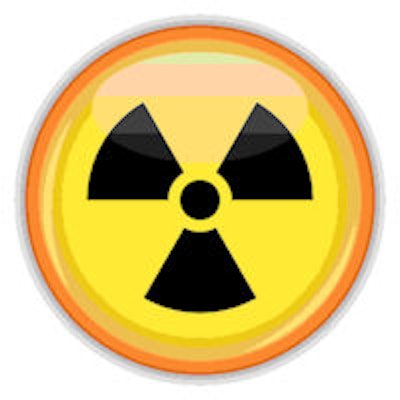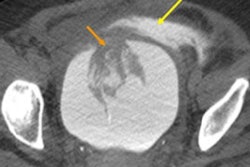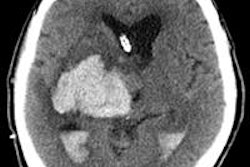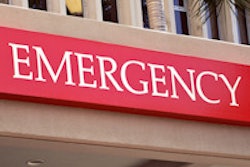
The use of CT for minor injuries has doubled in the past decade, according to a study of more than 8.5 million California patients in the Journal of Surgical Research.
Researchers examined the records of patients who presented to California emergency departments with minor trauma between 2005 and 2013. The probability of undergoing at least one CT scan before discharge doubled during the study period, from about 3.5% of patients in 2005 to more than 7%.
The sharp increase suggests it's time to redouble efforts to ensure that the use of radiation is appropriate, said senior investigator Dr. Renee Hsia from the University of California, San Francisco (UCSF), in an interview with AuntMinnie.com.
"We're not saying that all of these scans are not appropriate; what we can say from the study is that the rates of CT for minor trauma have doubled from 2006 to 2013," Hsia said. "And we have found patterns where, for example, Medicare patients can get more CTs because they're older."
Scans were also more common among younger patients ages 18 to 24, those older than 45, patients involved in car accidents, and self-pay patients, said Hsia, who is a professor of emergency medicine and health policy at UCSF.
Critical but overused?
The rise in CT use for trauma has come with good evidence that it reduces mortality, cuts time spent in the emergency department (ED), and speeds diagnosis while improving diagnostic accuracy, wrote Hsia and colleagues Gregory Tong from UCSF and Dr. Kristan Staudenmayer from Stanford University. But with the exception of head CT studies, few publications have examined whether scans for minor trauma are benefiting patients after accounting for the radiation burden and increased risk of cancer (J Surg Res, January 19, 2016).
This study looked for changes in the frequency of CT imaging for adults with minor trauma who presented to the emergency department but did not require admission. The researchers primarily analyzed emergency department and ambulatory surgery data from the California Office of Statewide Health Planning and Development for 348 state hospitals.
They identified 8,535,831 patients 18 years and older who had a traumatic E-code diagnosis (a range of ICD-9 codes used for initial evaluation of traumatic injury) and an injury severity score (ISS) of nine or less.
Those with codes related to accidental poisoning; adverse effects of surgical and medical procedures; accidents due to natural, environmental, and various other factors; and adverse effects of therapeutic drug use were excluded. Univariate and multivariate analysis was used to assess the clinical and hospital-related factors related to CT use for each year of the study period.
CT surges
Among all of the patients included, 502,418 (5.9%) received at least one CT scan prior to discharge. The percentage of patients who were scanned rose from 3.51% in 2005 to 7.17% in 2013 (p < 0.005).
"While CT has yielded significant benefit in our ability to treat complications from trauma and any medical condition in general, the flip side is that the threshold for ordering CT has decreased to the point where we need to ask ourselves: Are we performing imaging that may not be warranted and, therefore, subjecting patients to potentially unnecessary long-term radiation exposure?" Hsia told AuntMinnie.com.
Patients older than 45 and those 18 to 24 years were both likelier to be scanned, and overall, patients who received a CT scan were more likely to be non-Hispanic white and have Medicare or self-pay and/or be uninsured (p < 0.005), the group reported.
Also scanned more often were patients who had motor vehicle collision injuries (p < 0.005) and those seen at level I or II trauma centers (p < 0.005) -- possibly because these centers are accustomed to major trauma and may tend to scan more liberally, according to the authors.
The most common application, head CT, rose from 2.67% of patients in 2005 to 5.67% in 2013 (p < 0.005). Abdomen and pelvis CTs saw the greatest decrease in use during the period, falling from 0.57% in 2005 to 0.12% in 2013.
Even after adjusting for independent predictors of increased CT utilization, patients in 2013 still had a greater chance of receiving a CT compared to those in 2005 (odds ratio, 1.97).
A brief pause
The scan growth did take a pause, with CT utilization peaking in 2009 and then decreasing through 2011 before resuming growth to a new peak in 2013, the researchers found.
This pause came during a period of heightened awareness of radiation's risks, which may have encouraged physicians to take a closer look at their ordering patterns, according to Hsia. In 2009, the U.S. Food and Drug Administration (FDA) published a summary of the risks of radiation exposure, and an increased awareness of risk began in earnest about five to seven years ago.
"We can't say the slight decrease was due to that -- that's not something our study can do -- but it does parallel those trends, and then the rates go up again," she said.
Many theories have been offered to explain the increase in scans, ranging from CT's increased diagnostic power over x-ray to the efficacy of pan-scanning for major trauma, the greater availability of scanners, defensive medicine, and, last but not least, pressure to decrease patients' length of stay in the ED and speed discharges, the authors noted.
"The etiology is likely multifactorial, with no one particular factor driving the majority of this increase," they wrote.
The authors look forward to evaluating the 2014 data, just recently published, to see if the utilization trends continue. But in any case, Hsia pointed to a changing culture as a driver of the trend toward more scans and laxer attitudes.
"I have noticed a change in the culture, where some may be ordering imaging reflexively, as opposed to really putting careful thought into it, and I'm not saying emergency physicians," she said. "I work in a hospital where we have trauma surgeons and we make these decisions in consultation, and it might be the case where a trauma surgeon is very busy and doesn't have time to see that patient -- and their recommendation is a CT scan."
For example, the use of head CT has increased rapidly despite a growing body of validated guidelines for its use, she said.
The implementation of quality measures in recent years is likely an important factor as well. With an eye on costs, hospitals measure time to discharge and length of stay, "and there's a lot of pressure to shorten these times," Hsia said.
In the past, patients would be admitted for observation for eight or 12 hours to see if their pain increased or their vital signs changed, but now patients are more likely to be scanned and quickly discharged. Defensive medicine also favors more rather than less scanning, Hsia said.
"We have a culture where we tend to order more scans than other countries because we tend to be a litigious society," she said. "The downside of that is that we tend to expose patients more than other countries do."



















